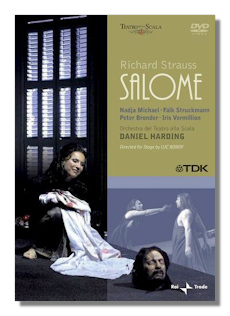
The Internet's Premier Classical Music Source
Related Links
- R. Strauss Reviews
- Latest Reviews
- More Reviews
-
By Composer
-
Collections
DVD & Blu-ray
Books
Concert Reviews
Articles/Interviews
Software
Audio
Search Amazon
Recommended Links
Site News
 DVD Review
DVD Review
Richard Strauss

Salome
- Nadja Michael (Salome)
- Falk Struckmann (Jochanaan)
- Peter Bronder (Herodes)
- Iris Vermilion (Herodias)
- Matthias Klink (Narraboth)
- Natela Nicoli (A Page)
Orchestra of the Teatro alla Scala/Daniel Harding
TDK DVWW-OPSALOME DDD 108:00 Widescreen LPCM Stereo Dolby DTS
This production, originally developed for the Salzburg Festival, was recorded at La Scala in March 2007. At its center, of course, is Nadja Michael in the title role. Salome has become this soprano's signature role, and there's a competing Opus Arte DVD of her performing it, this time from London's Royal Opera House. I haven't seen that production, but it is on two DVDs and therefore is significantly more expensive than the present one. That might be all some readers need to know.
Michael's biggest assets here are visual. She's young, attractive, athletic, a good actress, and a good dancer too. She does her own Dance of the Seven Veils, and does it well – for once, Herod's cries of "Herrlich!" do not seem misplaced. Director Luc Bondy encourages her to go off the deep end during the final scene, which more than hints at necrophilia, so easily offended viewers should consider themselves warned. In earlier scenes, there's a sense of innocence, albeit innocence gone wrong, but by the end of the opera, we know that this innocence has dissipated. One might argue that Herod's decision to kill Salome is as much to punish her for becoming a woman as it is a reaction to her antics with Jochanaan's head. Vocally, though, she's not a heavy-hitter in the tradition of great Salomes such as Birgit Nilsson, Hildegard Behrens, and Gwyneth Jones. She projects over the orchestra well, but the voice lacks heft and remains brightly monochromatic, except when she actually is distorting it for expressive effect. She also wobbles, although not to an alarming degree. The result is a performance that is dramatically satisfying, but somewhat less so vocally.
The rest of the cast sings well, although not memorably, and has to cope with the mix-and-match whims of Bondy and Susanne Raschig's costume design. Falk Struckmann is a sonorous, intense Jochanaan, but it doesn't help that he's been costumed to look like a caveman. Herodes is sung with less vocal caricature than one often hears in this role, although Peter Bronder has been given punky orange hair. Iris Vermilion's stentorian Herodias seems to have been inspired by Gloria Swanson. Narraboth is more traditionally garbed, but Herodias' Page has a Bride of Frankenstein streak of white running through his/her hair. One of the smaller roles seems to have been costumed in the style of Oscar Wilde himself. The set design suggests the past century, perhaps in some tottering, corrupt state. Of Herodes' wealth there is not a trace, until he pulls out his jewels in his vain attempt to dissuade Salome from claiming her gory prize. The cistern in which Jochanaan is imprisoned is more like a bunker, and a narrow trench irregularly bisects the stage; I kept waiting for one of the singers to fall in. The staging is fairly traditional, although before and after Salome's dance, the opera seems to be in danger of turning into a family drama for the royal couple and their spoiled daughter – "Bringing Up Father" Judean style?
Daniel Harding's conducting is responsive, colorful, and detailed, although he misses the sweep that one ideally wants in this score. Even more than usual, this Salome is an orchestral tone poem with voices.
The sound is fine, and so are the picture and videography, generally. We occasionally are allowed to watch the action as if we were in Jochanaan's cistern, however, which is ineffective, and not even particularly sensible, once he has been killed.
This is not a bad performance of Salome, but it doesn't quite come together, and if one doesn't want a Wagnerian voice in the title role, older versions by Maria Ewing, Teresa Stratas, and Catherine Malfitano are to be preferred.
Copyright © 2009, Raymond Tuttle




















